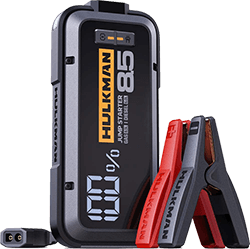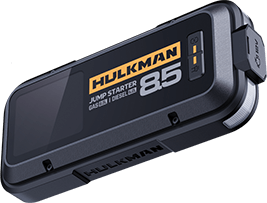Recent Articles
-
Understanding Lithium Battery Charging: Principles, Challenges, and How Hulkman Mega Engineers a Smarter System September 29, 2025
-
What Are Lithium Battery Cycle Counts and How to Extend Them? September 25, 2025
-
How to Properly Care for Lithium Battery Products September 24, 2025
Featured Products
note
What Are Lithium Battery Cycle Counts and How to Extend Them?
Lithium batteries power nearly everything in modern life—phones, laptops, drones, e-bikes, and portable power stations. One of the most important indicators of their longevity is the cycle count. Understanding what it means, what factors affect it, and how to extend it can make the difference between a battery that lasts a year and one that serves you for many years.
In this article, we’ll cover:
- What Is a Lithium Battery Cycle Count?
- What Affects Battery Cycle Life?
- Typical Cycle Life Across Battery Chemistries
- How to Extend Lithium Battery Life
- Conclusion: Mega Power Station Battery Cycle Advantage
What Is a Lithium Battery Cycle Count?
A cycle count refers to the number of times a battery has released energy equivalent to its rated capacity, then been fully recharged. In industry terms, one cycle equals the cumulative discharge of 100% of the rated capacity, whether used all at once or spread over multiple sessions.
Example:
- A 100 Ah battery used for 70 Ah today and 30 Ah tomorrow, then recharged = 1 cycle.
- The same 100 Ah battery used for 20 Ah, recharged, then 80 Ah, then recharged = also 1 cycle.
Importantly, reaching a certain cycle count doesn’t mean the battery is dead. Instead, it signals that the battery’s usable capacity has dropped to around 70–80% of its nominal value (the standard rating set by the manufacturer under test conditions). At that point, devices may show noticeably shorter runtimes.
What Affects Battery Cycle Life?
Lithium battery cycle life is not fixed—it depends on how the battery is used and stored. Key factors include:
Depth of Discharge (DOD): The deeper the discharge, the greater the stress on the electrode structure. Frequent 80% discharges will yield far fewer cycles than shallower 40–60% discharges.
Charge/Discharge Rate (C-rate): Higher rates increase polarization voltage and temperature. This can trigger lithium plating on the anode and accelerate the growth of the SEI (solid electrolyte interface), both of which reduce cycle life.
Temperature (Arrhenius Law): High heat dissolves and rebuilds the SEI layer, while cold slows ion movement, causing lithium plating. Both extremes shorten lifespan.
Cut-Off Voltage: Charging above recommended limits (e.g., >4.2 V for NCM, >3.65 V for LFP) or discharging too low (e.g., <2.75 V NCM, <2.50 V LFP) accelerates degradation. Every 0.1 V above the limit can cut cycle life by half.(Battery University)
Storage Practices: Long-term storage at high states of charge accelerates capacity loss, while storing at 30–50% is far safer. Mechanical shocks or vibration also create cracks that force repeated SEI regeneration.
System-Level Factors (BMS & Cooling): In packs, uneven cell temperatures (>5 °C difference) cause unequal aging, reducing pack life. Weak balancing currents in BMS can leave some cells overcharged or over-discharged, lowering effective cycles.
Typical Cycle Life Across Battery Chemistries
|
Battery Type |
Typical Cycles (to 80% SOH) |
Peak in Lab Conditions |
|
LFP (Lithium Iron Phosphate) |
2,000–3,000 |
up to 6,000 |
|
NCM (Nickel Cobalt Manganese) |
800–1,500 |
up to 2,000 |
|
LCO (Lithium Cobalt Oxide) |
500–800 |
~1,000 |
|
LMO (Lithium Manganese Oxide) |
1,000–2,000 |
~2,500 |
This explains why LFP is favored for long-life stationary storage and NCM for high-energy EVs and power stations where higher energy density matters.
How to Extend Lithium Battery Life
Avoid Deep Discharges: Keep usage between 20–80% of capacity to reduce electrode stress and double cycle life.
Charge Slowly When Possible: Use ≤1C charging rates, and after fast charging, let the battery rest for a few minutes to stabilize.
Maintain Stable Temperatures: Operate in the 15–35 °C range; preheat before charging in freezing weather, and use cooling when above 45 °C.
Respect Voltage Limits: For NCM cells, keep below ~4.1 V; for LFP, ~3.55 V. Each 0.1 V reduction can extend life by 30–50%.(Budget Light Forum)
Store at Mid-Range SOC: For long-term storage, keep between 30–50% charge and top up every 3 months.
Choose a Quality BMS: A strong Battery Management System ensures even temperatures and balancing currents, extending pack life by 15% or more.
Conclusion: Mega Power Station Battery Cycle Advantage
Mega power station use NCM lithium batteries, the same chemistry trusted in performance EVs. While NCM cells typically offer 800–1,500 cycles, Mega power station design maximizes their potential:
Dual Thermal Management: Mega power station employs both upper and lower cooling layers to minimize internal temperature differences—something most consumer power stations skip.
Clean Internal Layout: Reduced wiring clutter lowers resistance and heat, protecting cycle life.
Robust BMS Integration: Balances cells precisely, preventing premature degradation.
Worry-Free Warranty: With a 5-year guarantee and a companion app for real-time updates, community advice, and firmware support, Mega ensures you get the most out of every cycle.
In short, while chemistry sets the baseline, engineering and usage habits determine the true lifespan. Mega pairs advanced NCM cells with system-level safeguards so your battery delivers reliable power—cycle after cycle.
Learn more and use exclusive code "TNZG4NC7" to get 25% discount at checkout!






















